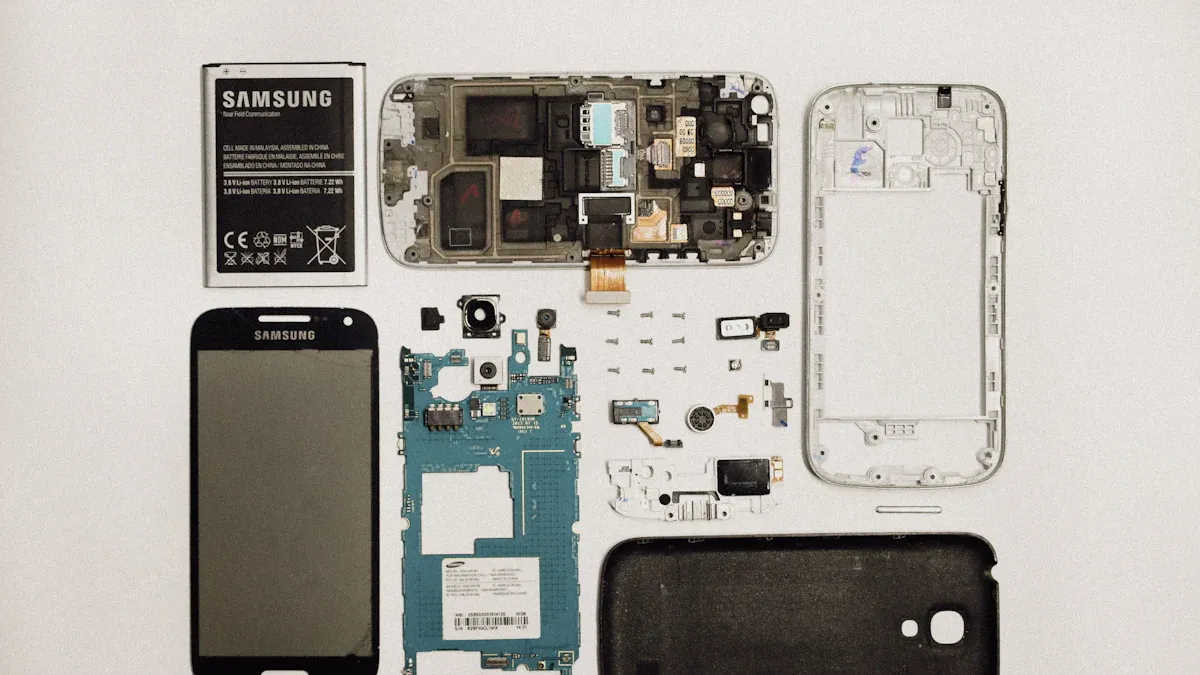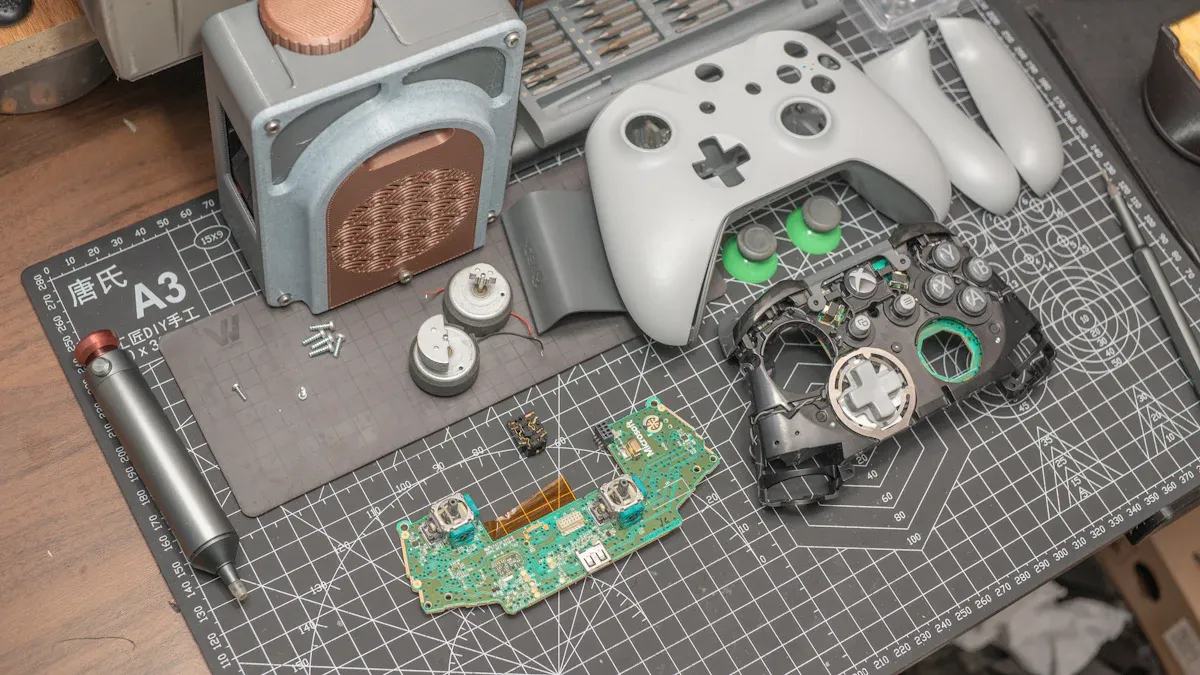UPA2352BT1P‑E4 vs UPA2351BT1P‑E4, Renesas, Dual N‑MOSFETs for Li‑Ion Battery Protection

UPA2352BT1P‑E4 vs UPA2351BT1P‑E4 shows a clear difference in performance for Li-Ion battery protection. UPA2352T1P-E4-A provides a lower Rds(on), a compact LGA package, and a logic-level gate drive, making it more suitable for space-constrained and efficient battery circuits. UPA2351T1P-E4-A offers a different footprint but does not match the space-saving or efficiency benefits. Selecting the right MOSFET ensures battery safety and maximizes energy efficiency in demanding applications.
Key Takeaways
UPA2352BT1P‑E4 offers lower resistance and less heat, improving battery life and efficiency.
Its small 4-pad LGA package saves space, making it ideal for compact devices like smartphones and wearables.
The logic-level gate drive allows easy control with low-voltage microcontrollers, simplifying circuit design.
UPA2351BT1P‑E4 fits traditional layouts but has higher resistance and a larger package, which may reduce efficiency.
Choosing the right MOSFET balances board space, power loss, and control voltage to ensure safe and efficient battery protection.
Comparison Table

Key Specs
The table below shows a direct comparison of the most important specifications for UPA2352BT1P‑E4 and UPA2351BT1P‑E4. These specs help engineers decide which device fits best in a Li-Ion battery protection circuit.
Specification | UPA2352BT1P‑E4 | UPA2351BT1P‑E4 |
|---|---|---|
Channel Type | Dual N‑MOSFET | Dual N‑MOSFET |
RDS(on) | ~43 mΩ @ 4.5 V, 2 A | ~60 mΩ @ 4.5 V, 2 A |
Gate Drive Voltage | 2.5 V (logic-level) | 4.5 V (standard) |
Max Drain Current | 2 A | 2 A |
Package Type | 4‑pad LGA (EFLIP, 1.4×1.4 mm) | 6‑pin TSOP (2.9×2.8 mm) |
Protection Diode | Yes (G‑S ESD protection) | Yes (G‑S ESD protection) |
Common Drain | Yes | Yes |
Tip: Lower RDS(on) means less heat and higher efficiency in battery circuits.
Feature Highlights
UPA2352BT1P‑E4 uses a compact LGA package. This design saves space on the PCB and fits well in small devices.
The logic-level gate drive allows direct control from low-voltage microcontrollers. This feature helps designers build efficient and simple circuits.
Both MOSFETs offer dual N-channel configuration with internal common drains. This setup supports back-to-back switching, which is important for safe charge and discharge paths in Li-Ion battery protection.
UPA2352BT1P‑E4 vs UPA2351BT1P‑E4 shows a clear difference in RDS(on) and package size. UPA2352BT1P‑E4 provides lower conduction losses and a smaller footprint, making it ideal for compact and energy-efficient designs.
Note: Engineers should consider both the electrical specs and the physical size when choosing a MOSFET for battery protection.
Features
Electrical
Engineers often compare UPA2352BT1P‑E4 vs UPA2351BT1P‑E4 by looking at their electrical performance. UPA2352BT1P‑E4 features a low on-resistance (RDS(on)) of about 43 mΩ at a 4.5 V gate drive and 2 A drain current. This low resistance helps reduce power loss and heat, which is important for battery-powered devices. The device supports a logic-level gate drive, so it can turn on fully with only 2.5 V at the gate. This makes it easy to control with modern microcontrollers.
UPA2351BT1P‑E4 has a higher RDS(on) of about 60 mΩ under similar conditions. Both MOSFETs can handle up to 2 A of drain current, which suits most small battery protection circuits. For reference, some MOSFETs in this class can reach even lower on-resistance and higher current ratings, such as 1.38 mΩ at 4.5 V and 25 A at 25°C, but these values depend on the specific device and application.
Package
The package type affects how much space the MOSFET uses on a printed circuit board. UPA2352BT1P‑E4 comes in a 4-pad LGA (EFLIP) package that measures only 1.4 × 1.4 mm. This compact size allows engineers to design smaller and lighter battery packs. The flip-chip layout also improves thermal performance and electrical connection.
UPA2351BT1P‑E4 uses a 6-pin TSOP package with a larger footprint of 2.9 × 2.8 mm. This size may fit less easily into compact devices. The difference in package size often guides the choice for space-constrained designs.
Tip: A smaller package can help reduce the overall size of the battery protection circuit.
Protection
Both MOSFETs include built-in gate-to-source (G‑S) protection diodes. These diodes help protect the device from electrostatic discharge (ESD), which can damage sensitive electronics. The dual N-channel configuration with a common drain supports back-to-back switching. This feature is important for safe charge and discharge control in lithium-ion battery packs.
Designers can rely on these protection features to improve the reliability and safety of their battery management systems. The UPA2352BT1P‑E4, with its compact package and logic-level gate drive, offers extra flexibility for modern, space-saving designs.
UPA2352BT1P‑E4 vs UPA2351BT1P‑E4
Performance
Engineers often look at performance first when comparing MOSFETs for Li-Ion battery protection. UPA2352BT1P‑E4 delivers lower on-resistance, which means less energy turns into heat during operation. This feature helps batteries last longer and stay cooler. The logic-level gate drive allows UPA2352BT1P‑E4 to work directly with low-voltage controllers. This makes it easier to design circuits that use less power. UPA2351BT1P‑E4, with its higher on-resistance, may cause more power loss in the same application. Both devices support up to 2 A of current, which fits most small battery packs. However, UPA2352BT1P‑E4 stands out for its efficiency and lower heat generation.
Note: Lower RDS(on) values help improve battery run time and device safety.
Design
Designers often choose components based on size and flexibility. UPA2352BT1P‑E4 uses a 4-pad LGA package that measures only 1.4 × 1.4 mm. This small footprint saves valuable space on the circuit board. It fits well in slim devices like smartphones, power banks, and wearables. The flip-chip layout also improves heat dissipation and electrical contact. UPA2351BT1P‑E4 comes in a larger TSOP package, which may not suit very compact designs. Both MOSFETs offer dual N-channel configuration with a common drain, supporting safe charge and discharge paths. UPA2352BT1P‑E4 gives engineers more options for space-saving and modern layouts.
UPA2352BT1P‑E4: Best for compact, high-density designs.
UPA2351BT1P‑E4: Fits traditional layouts with more board space.
Cost
Cost and availability play a role in every project. UPA2352BT1P‑E4 uses advanced packaging, which may affect its price compared to standard packages. However, the benefits in efficiency and board space can offset the initial cost in many designs. UPA2351BT1P‑E4 may offer a lower price point in some markets due to its standard TSOP package. Both devices are widely available from major distributors. Engineers should weigh the total system cost, including board size and energy savings, when making a choice.
Tip: Consider both the price of the MOSFET and the savings from a smaller, more efficient design.
Pros and Cons
UPA2352BT1P‑E4
Offers a compact 4-pad LGA package. This small footprint helps engineers design slim and lightweight battery packs.
Features a low RDS(on) of about 43 mΩ. Lower resistance means less heat and higher efficiency in battery protection circuits.
Supports logic-level gate drive. Designers can use low-voltage microcontrollers for direct control, which simplifies circuit design.
Includes a built-in gate-to-source protection diode. This feature improves reliability by protecting against electrostatic discharge.
Provides a dual N-channel configuration with a common drain. This setup supports safe charge and discharge paths in lithium-ion batteries.
Suitable for modern, space-constrained devices like smartphones, wearables, and power banks.
🛡️ Tip: UPA2352BT1P‑E4 works well in applications that demand high efficiency and minimal board space.
UPA2351BT1P‑E4
Uses a standard 6-pin TSOP package. This larger footprint may fit better in traditional circuit layouts.
Has an RDS(on) of about 60 mΩ. Higher resistance can lead to more power loss and heat in battery circuits.
Requires a standard gate drive voltage of 4.5 V. Some designs may need extra circuitry to provide this voltage.
Also includes a gate-to-source protection diode for ESD protection.
Offers a dual N-channel configuration with a common drain, supporting safe battery operation.
Fits applications where board space is less limited and standard packages are preferred.
🔍 Note: UPA2352BT1P‑E4 vs UPA2351BT1P‑E4 shows clear differences in size and efficiency. Engineers should match the MOSFET to the needs of their specific battery protection design.
Recommendation
Best Use
Engineers should select UPA2352BT1P‑E4 for compact and high-efficiency battery protection circuits. This device fits best in applications where space is limited, such as smartphones, wearables, and portable power banks. Its low RDS(on) helps reduce heat and power loss, which improves battery life and safety. The logic-level gate drive allows easy control with modern microcontrollers. UPA2351BT1P‑E4 works well in traditional designs where board space is less restricted and standard packages are preferred.
For projects that demand a small footprint and high energy efficiency, UPA2352BT1P‑E4 stands out as the top choice.
Summary
When comparing UPA2352BT1P‑E4 vs UPA2351BT1P‑E4, engineers should focus on three main factors:
Board Space: UPA2352BT1P‑E4 uses a compact LGA package, saving valuable PCB area.
Efficiency: Lower RDS(on) in UPA2352BT1P‑E4 means less heat and longer battery life.
Control Voltage: Logic-level gate drive in UPA2352BT1P‑E4 supports direct connection to low-voltage controllers.
Engineers should match the MOSFET to the needs of their battery protection circuit. UPA2352BT1P‑E4 offers the best solution for modern, space-saving, and energy-efficient designs.
UPA2352BT1P‑E4 stands out with its lower Rds(on), compact LGA package, and logic-level gate drive. These features make it the best choice for Li-Ion battery protection in space-limited and energy-efficient designs. UPA2351BT1P‑E4 fits traditional layouts but does not match the efficiency or size benefits. Engineers should review datasheets and match the MOSFET to their specific design needs for the safest and most reliable battery protection.
Always check the latest datasheets before finalizing component selection.
FAQ
What makes UPA2352BT1P‑E4 better for compact devices?
UPA2352BT1P‑E4 uses a 4-pad LGA package that measures only 1.4 × 1.4 mm. This small size fits well in slim devices like wearables and smartphones.
Can both MOSFETs handle the same current?
Yes. Both UPA2352BT1P‑E4 and UPA2351BT1P‑E4 support up to 2 A of drain current. This rating suits most small lithium-ion battery protection circuits.
Why does RDS(on) matter in battery protection?
Lower RDS(on) means less power loss and heat during operation. UPA2352BT1P‑E4 offers lower RDS(on), which helps batteries last longer and stay cooler.
Do these MOSFETs need special gate drive voltages?
UPA2352BT1P‑E4 works with a logic-level gate drive of 2.5 V. UPA2351BT1P‑E4 needs a standard 4.5 V gate drive. Designers should match the gate drive to their controller.
Are both devices protected against ESD?
Both MOSFETs include a built-in gate-to-source protection diode. This feature helps protect the device from electrostatic discharge (ESD) damage.
See Also
Explore The LPQ252-CEF For Optimized Power Efficiency
Why M30280FAHP Is Trusted For Medical Integrated Circuits
Harnessing AD74413RBCPZ To Improve Process Control Systems
CALL US DIRECTLY
(+86)755-82724686
RM2508,BlockA,JiaheHuaqiangBuilding,ShenNanMiddleRd,Futian District,Shenzhen,518031,CN
www.keepboomingtech.com sales@keepboomingtech.com
